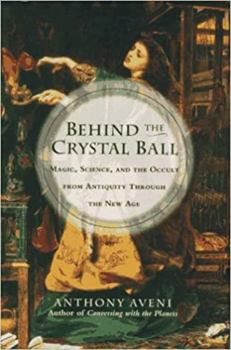Behind the Crystal Ball
Select Format
Select Condition 
Book Overview
In this fascinating exploration of occult practice, Anthony Aveni takes the reader on a whirlwind tour through time and space to unveil the many ways people have used magic over the millennia in hopes... This description may be from another edition of this product.
Format:Hardcover
Language:English
ISBN:0812924150
ISBN13:9780812924152
Release Date:July 1996
Publisher:Crown Publishing Group (NY)
Length:406 Pages
Weight:1.70 lbs.
Dimensions:1.4" x 6.5" x 9.6"
Customer Reviews
2 ratings
New ways of seeing...
Published by Thriftbooks.com User , 17 years ago
While Behind the Crystal Ball may not be an in depth study of the subject, I found it to be one of those rare books, like Richard Bach's Illusions, that gives the reader completely new ways of looking at the world. While there are numerous histories of magic and the occult, Aveni differs in that he shows the overlap between science and, occasionally, established religion with magical practices. Moreover he explains how our way of separating magic from science, and or even defining what we would call "true" magic instead of stage fakery, is influenced by our common societal beliefs and how other societies define these beliefs differently. I found this to be a book that completely rearranged my thinking, giving me completely new insights into the varying ways the common culture has looked at various magical practices though history, especially during the Renaissance and modern age.
Worthwhile book on subject
Published by Thriftbooks.com User , 25 years ago
I was surprised this 1996 book is already out of print! The book examines different ways that man through history has been attracted to "magic," seemingly defined as "that which does not bear up under the Western scientific method." The individual chapters on types of "magic" in history, such as alchemy and mesmerism, are interesting, although episodic. They sometimes suffer from an over-abundance of fine detail and too much direct quotation of primary and secondary sources, in what is essentially a chapter review of certain practices. The author shines best in his chapters labeled "summaries," and in the final four chapters and epilogue where he attempts to bring it all together. He suggests that no one theory or world view explains all observations, and that perhaps multiple realities exist simultaneously. "'There is no system of truth with which to account for all aspects of being.' ... [B]oth science and magic ... have definite tools and methods, separate technologies, contrastable rational procedures, and systematic bodies of knowledge.... "When we cast modern scientific spells upon the world in order to control it we too are engaging in a form of religious ritual, albeit one that depends more upon the worship of the book and the computer than on eliciting the power of the spoken word. Incidentally, this religion too has its fanatics.... "Are there multiple realities, other subuniverses of the mind that lie beneath the concrete, sensible world in which we place all our faith? ... Perhaps the thought planes that we perceive are all there at the same time and we spend our days and nights switching channels from one to the other. Some of us give better Nielsens to the magic channel than to the reason channel because we enjoy its programs more." While the author is generally understanding of the need to do "magic," he strangely distances magic from orthodox religion, although his book-opening quote is "one man's religion is another man's superstition." An examination of how Western man tries to reconcile scientific method with orthodox religious beliefs, which, even if "real," entail belief in unseen beings and a history that is largely not provable, together with a belief that unseen beings assist or hinder us in our daily lives, would have been beneficial in comparison to the unseen beings and cosmological history that Westerners see as untrue.






